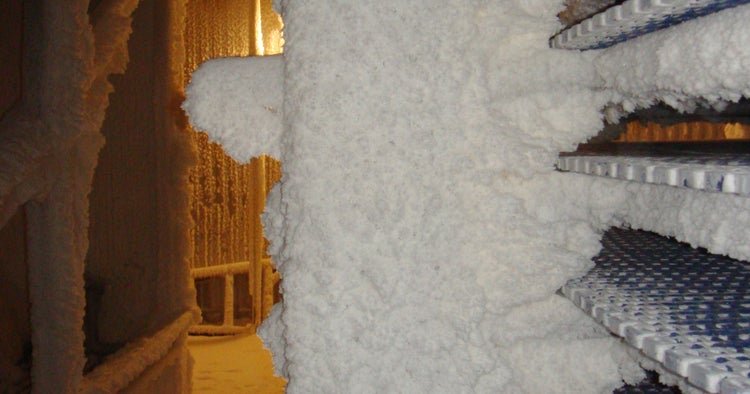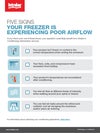What Condition Is Your Conditioning In?
Avoid high costs due to poor airflow
- Insights
- May 8, 2023

“Most customers with older machines do have airflow problems,” says Baili Tian, Mechanical Engineer at Intralox. “They might think they have strong airflow because they feel it in their enclosure, but that doesn’t necessarily mean the airflow has really been used effectively.”
Conditioning applications can rank among the costliest elements of a plant’s operation in terms of both product waste and energy usage, but they’re also often among the least understood and addressed. And—while applications may range from freezing chicken to proofing dough to cooling cookies—the bulk of conditioning problems occur in freezers and forced-air coolers, typically due to poor airflow.
“It’s very common,” says David Bogle, Global R&D Director for Spiral at Intralox. “People say, ‘I’ve got these huge fans—walk in there; it’s super cold.’ But if you could get to where the product is sitting, you might find out you don’t have any airflow over the actual product.”
The impact of poor airflow in these conditioning applications can be enormous, creating downtime, food safety risks, product delays, and other complications hidden in plain sight. Conversely, that means optimized airflow can directly result in energy savings, increased throughput, and improved operational efficiency.
“You need good air velocity for convective heat transfer—blowing heat off the product,” Bogle continues. “Similar to wind chill: wind moving across your skin makes you feel colder because it’s blowing the heat layer off of your skin. Air moving across the product has a dramatic impact on its actual cooling.”
We spoke further with our experts to discover the benefits of optimizing your conditioning applications.
Improve product quality, safety, and throughput
When your conditioning applications run more efficiently, your products reach their desired temperatures faster, meaning more product leaves your line at a faster rate. This—speed of production—is the simplest of the benefits to see at a quick glance.
“Sometimes people can’t get the product cool enough, so they have to run it into a retention freezer or something and let it sit there for two days to finish cooling off,” Bogle says. “That’s an inefficiency.”
But slow conditioning can also create costly waste and product loss. Among other nuisances, large ice crystals can form or moisture can be lost during inefficient applications, severely compromising product quality.
Worse still, the longer conditioning takes, the more opportunity there is for harmful bacteria to form in your products, putting your customers in danger of foodborne illness and you in danger of recalls.
“The faster you can cool off your product, the less opportunity you have for it to grow bad things like Listeria or Salmonella,” Bogle says.
It’s about optimization—you could cool off your product faster, which means you can get product through your line faster. It could mean you put out a better-quality product. It could mean that you improve your yield. And then it could mean simply saving energy.
David Bogle
Global R&D Director for Spiral at Intralox
Reduce energy usage and cost
The money saved by optimizing your conditioning applications isn’t limited to its effect on product output and quality. As we complete more energy studies with our customers, we continue to find that energy savings can add up quickly as well.
“Let’s say that, sure, they’re getting their products super cold,” Bogle says, “but that using our wind tunnel and improving the system, we could let them run their freezer at -30°F (-34.4°C) instead of -40°F (-40°C) and their product would still reach the same core temperature. That’s a huge savings.”
Improving poor conditioning can also reduce the amount of start-stop operation by enhancing airflow and air balance.
“In some cases, customers have to stop every 12 hours or 24 hours because they get too much moisture in their system and it plugs up the coil,” Bogle says. “We can help with the layout of the system to give them more runtime between forced shutdowns.”
Combining these improvements can save stress and energy across your whole system—reducing the work of your compressors, fans, and motors and allowing them to generate less heat.
“The energy and dollar savings can be up to 15%,” Tian says, “depending on the kind of fan, the motor, and the goal of the customer.”
Optimize your conditioning with Intralox
You can—and should—look into the quality of your operation’s conditioning right now. Our high-level checklist for signs of poor airflow is a great start and will help you identify inefficiencies in your applications.
We also offer Conditioning Optimization services—available exclusively from Intralox—which help food processors achieve maximum conditioning efficiency. Allowing Intralox to optimize airflow in your conditioning applications:
- Maximizes runtime and reduces dwell time
- Minimizes bacteria growth for improved food safety
- Freezes product faster, decreasing waste due to moisture loss or large ice crystals
- Reduces overall ice buildup on products, equipment, and belt
- Enhances fan and coil performance
- Saves on energy usage and costs
“We visit the site and use our airflow meter to take readings and see what the product is experiencing,” Tian says. “From there, we build a CAD model to show the customer what it looks like currently and what we can improve. Then, if we implement the changes from our simulations, we come back afterward and do the readings over again to show them a direct comparison and ensure it got them good results.
“We’re not just presenting them with a model and a set of recommendations,” Tian continues. “We can actually go in and make the changes for them.”
Visit our spiral services page for more information about optimizing your conditioning applications.

